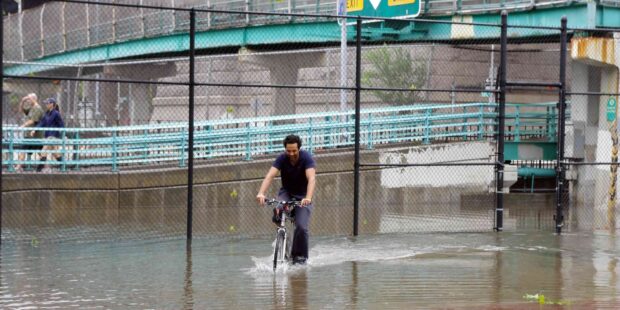
Resilient leaders are coming up with sustainable solutions, enhancing and upgrading urban environments to safeguard critical assets and infrastructure
By Edgar Westerhof
In the face of escalating climate extremes, cities all across America are stepping up as leaders in building resilience and mitigating the impact of climate change. Cities recognize the urgent need to prevent loss of life and economic disruption, prompting them to connect various scales and actors to address vulnerabilities in infrastructure.
A particular emphasis is placed on stormwater management and safeguarding critical assets and infrastructure. This paradigm shift has propelled cities from merely understanding risks to actively preparing for the extreme, challenging traditional engineering norms that, although suitable for normal circumstances, may not be adaptive, sustainable and safe in the long run.
Cities have found themselves at the forefront of climate adaptation efforts, driven by a profound understanding of the necessity to safeguard their residents and economies. At the same time, cities are adopting larger-scale green infrastructure solutions to enhance their urban environments and make them more attractive. These urban centers have embarked on a journey that transcends traditional boundaries and scales, focusing on innovative and multi-functional approaches to tackle climate-related challenges head-on.
Stormwater Management: A Crucial Focus
One of the key areas of concern for cities is stormwater management. As climate change intensifies, the frequency and severity of rainfall events are on the rise, posing a significant threat to urban environments. Traditional drainage systems, designed based on historical climate data, often prove inadequate to handle the deluge of water that accompanies these extreme weather events, such as Hurricane Ida, the intense 2021 Atlantic storm that wrecked some of the most hurricane damage on record in the U.S.
Cities are adapting by revisiting their stormwater management strategies. They recognize that larger water storage systems and delayed run-off solutions are essential to guide excess rainwater away from densely populated communities and critical assets. Under programs like New York City’s Cloudburst Project, which received $400 million in expansion funding in early 2023, reservoirs and green infrastructure such as parks are being utilized and integrated into urban landscapes to minimize flooding risks.
Additionally, the incorporation of smart technology through real-time monitoring is enhancing the efficiency of existing drainage systems, while weather forecasting allows cities to predict and respond to weather-related challenges more effectively.
Of course, while the challenges of managing excessive stormwater do garner a great deal of attention and focus in engineering and urban planning spheres, the flip side of the coin—insufficient water – is also a huge issue in many parts of the country. This issue is particularly relevant in western regions such as California, where cities like Los Angeles are grappling with the imperative to bolster their water systems’ resilience.
Overall, the multifaceted challenge of integrating various water sources, including groundwater, watershed water, river water and desalination pools into a single, cohesive system is an extremely complex endeavor that poses a unique set of hurdles that require a focused and equally urgent discussion.
Challenging Traditional Policy and Engineering Norms
The urgency of climate adaptation starts to prompt cities to challenge conventional policies and engineering norms. While these norms are crucial for routine performance and infrastructure upkeep, they may not be suited to withstand the escalating impacts of climate change. Cities are taking a proactive stance, evaluating existing policies and investing in updates to their existing plans and retrofitting solutions.
Updating plans regularly is imperative to account for increasingly extreme climate scenarios. Cities understand that failure to adapt now, often in known vulnerable locations, will lead to dire consequences in the future. This adaptive approach means rethinking urban development, infrastructure design and land use and community planning to better align with the changing climate landscape while educating stakeholders and communities on the need.
Equity and Vulnerable Communities: A Priority
In the quest for resilience, cities are keenly aware of the need to address equity issues and protect vulnerable communities. The impacts of climate change disproportionately affect low-income neighborhoods and marginalized populations. Ensuring that adaptation efforts are equitable and inclusive is a central concern and protecting the most vulnerable neighborhoods has to be a priority.
Cities are actively engaging with communities to explain the need for more robust system upgrades and develop tailored resilience strategies. These initiatives include disaster preparedness programs, neighborhood flood plans and projects that empower individuals to take proactive measures. By involving the most affected communities in the planning process, cities can strive to create solutions that are not only effective but also socially just.
Retrofitting Scalable Solutions in Complex Urban Spaces
Urban environments present unique challenges when it comes to climate adaptation. The density of buildings and infrastructure, coupled with limited available space, necessitates innovative approaches. Cities can focus on scalable solutions that are interconnected while optimizing and revitalizing neighborhoods at the same time.
Green spaces, such as low-lying parks, green roofs and permeable pavements, are increasingly being integrated into the urban fabric, helping to restore the natural water cycle. These elements not only enhance quality of life but also serve as natural buffers against flooding and heat. And this is where size matters: future-proofing communities has everything to do with planning for and implementing robust solutions to store and infiltrate large quantities of water.
Collaboration: The Cornerstone of Success
The success of urban climate adaptation efforts hinges on collaboration. Cities are breaking down silos and fostering partnerships with various stakeholders to create resilient, sustainable urban environments.
Private industry is playing a vital role, too, with an array of business, architecture and engineering and technology firms, as well as NGOs and academic institutions, all contributing toward innovative solutions. Public-private-academic partnerships, in particular, help to increase capacity and accelerate the development and implementation of resilient infrastructure.
Within this mix, research institutions and universities greatly contribute to the knowledge base needed to address urban challenges effectively, by providing invaluable insights and data-driven strategies, while educating the new workforce needed to address the massive challenge ahead of us. By identifying pilot projects, cities have an opportunity to elevate these newly established partnerships and drive innovation more aggressively.
Government agencies at the federal, state and local levels are instrumental in shaping progressive policies that drive efficiency and provide essential funding for climate adaptation projects. Coordination between all actors is essential to ensure that cities receive the support they need.
In conclusion, cities have emerged as resilient leaders in the face of escalating climate extremes. They are challenging traditional policies and norms, updating plans and prioritizing equity and vulnerable communities in their adaptation efforts. By identifying scalable solutions for complex retrofits and fostering collaboration among diverse stakeholders, cities are not only starting to understand the risks but also hold the key to preparing for the extreme, building a future that is adaptive, sustainable and inclusive.
Edgar Westerhof is vice president of Arcadis, the North America solution leader for climate adaptation.














